JEEP GRAND CHEROKEE 2013 Owner handbook (in English)
Manufacturer: JEEP, Model Year: 2013, Model line: GRAND CHEROKEE, Model: JEEP GRAND CHEROKEE 2013Pages: 408, PDF Size: 3.21 MB
Page 61 of 408
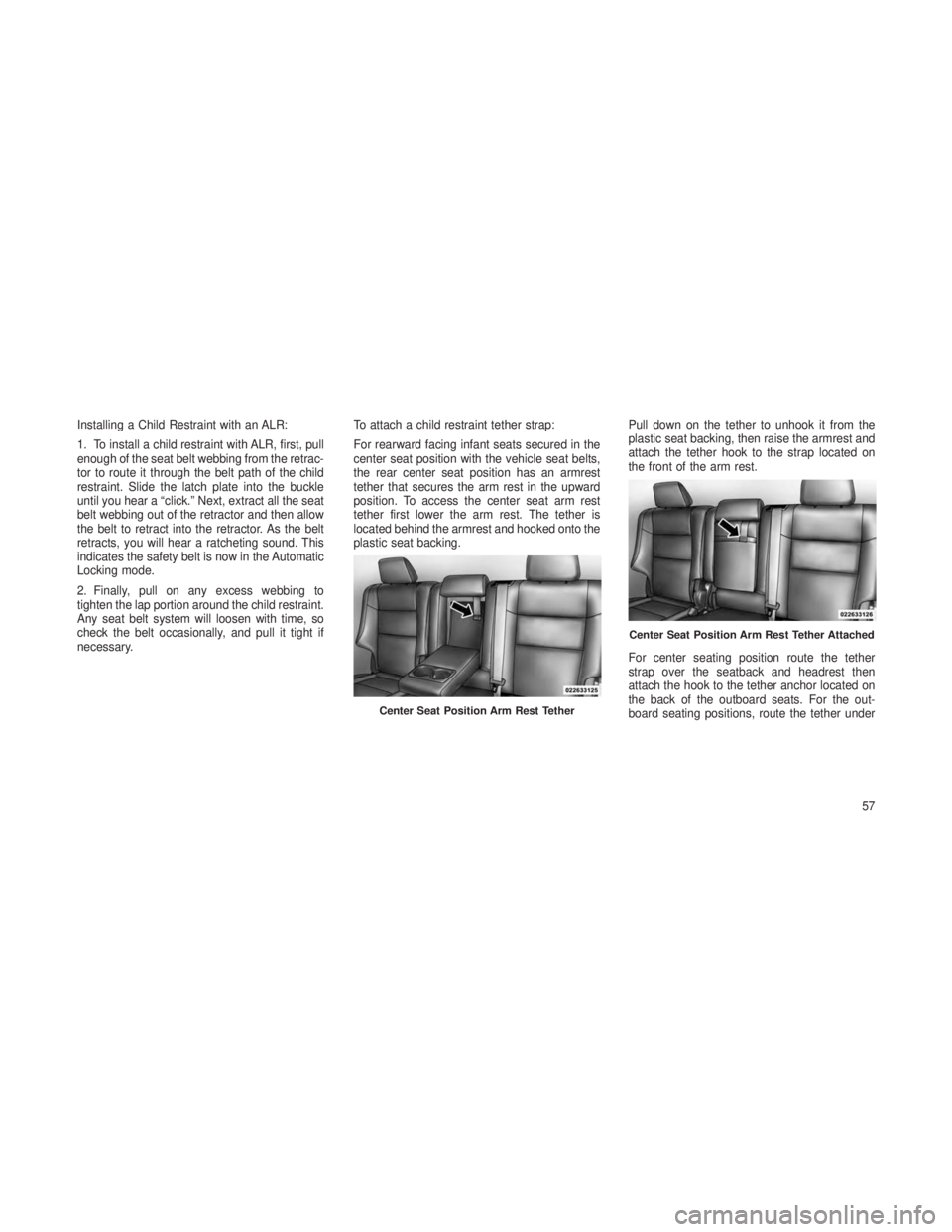
Installing a Child Restraint with an ALR:
1. To install a child restraint with ALR, first, pull
enough of the seat belt webbing from the retrac-
tor to route it through the belt path of the child
restraint. Slide the latch plate into the buckle
until you hear a “click.” Next, extract all the seat
belt webbing out of the retractor and then allow
the belt to retract into the retractor. As the belt
retracts, you will hear a ratcheting sound. This
indicates the safety belt is now in the Automatic
Locking mode.
2. Finally, pull on any excess webbing to
tighten the lap portion around the child restraint.
Any seat belt system will loosen with time, so
check the belt occasionally, and pull it tight if
necessary.To attach a child restraint tether strap:
For rearward facing infant seats secured in the
center seat position with the vehicle seat belts,
the rear center seat position has an armrest
tether that secures the arm rest in the upward
position. To access the center seat arm rest
tether first lower the arm rest. The tether is
located behind the armrest and hooked onto the
plastic seat backing.
Pull down on the tether to unhook it from the
plastic seat backing, then raise the armrest and
attach the tether hook to the strap located on
the front of the arm rest.
For center seating position route the tether
strap over the seatback and headrest then
attach the hook to the tether anchor located on
the back of the outboard seats. For the out-
board seating positions, route the tether under
Center Seat Position Arm Rest Tether
Center Seat Position Arm Rest Tether Attached
57
Page 62 of 408

the head restraints, and attach the hook to the
top tether anchor located on the back of the
seat. To access the top tether strap anchorages
behind the rear seat, pull the carpeted floor
panel away from the seat back, this will expose
the top tether strap anchorages.WARNING!
•
An incorrectly anchored tether strap could
lead to increased head motion and possible
injury to the child. Use only the anchor
positions directly behind the child seat to
secure a child restraint top tether strap.
•Do not use the cargo tie downs located on
the load floor. Improper usage of the tether
can lead to a failure of an infant or child
restraint. The child could be badly injured
or killed.
Transporting Pets
Air Bags deploying in the front seat could harm
your pet. An unrestrained pet will be thrown
about and possibly injured, or injure a passen-
ger during panic braking or in a collision.
Pets should be restrained in the rear seat in pet
harnesses or pet carriers that are secured by
seat belts.
Pulling Down The Carpet Floor Panel To Access Top Tether Strap
Top Tether Strap Anchorage(Located on Seatback)
Top Tether Strap Mounting
58
Page 63 of 408
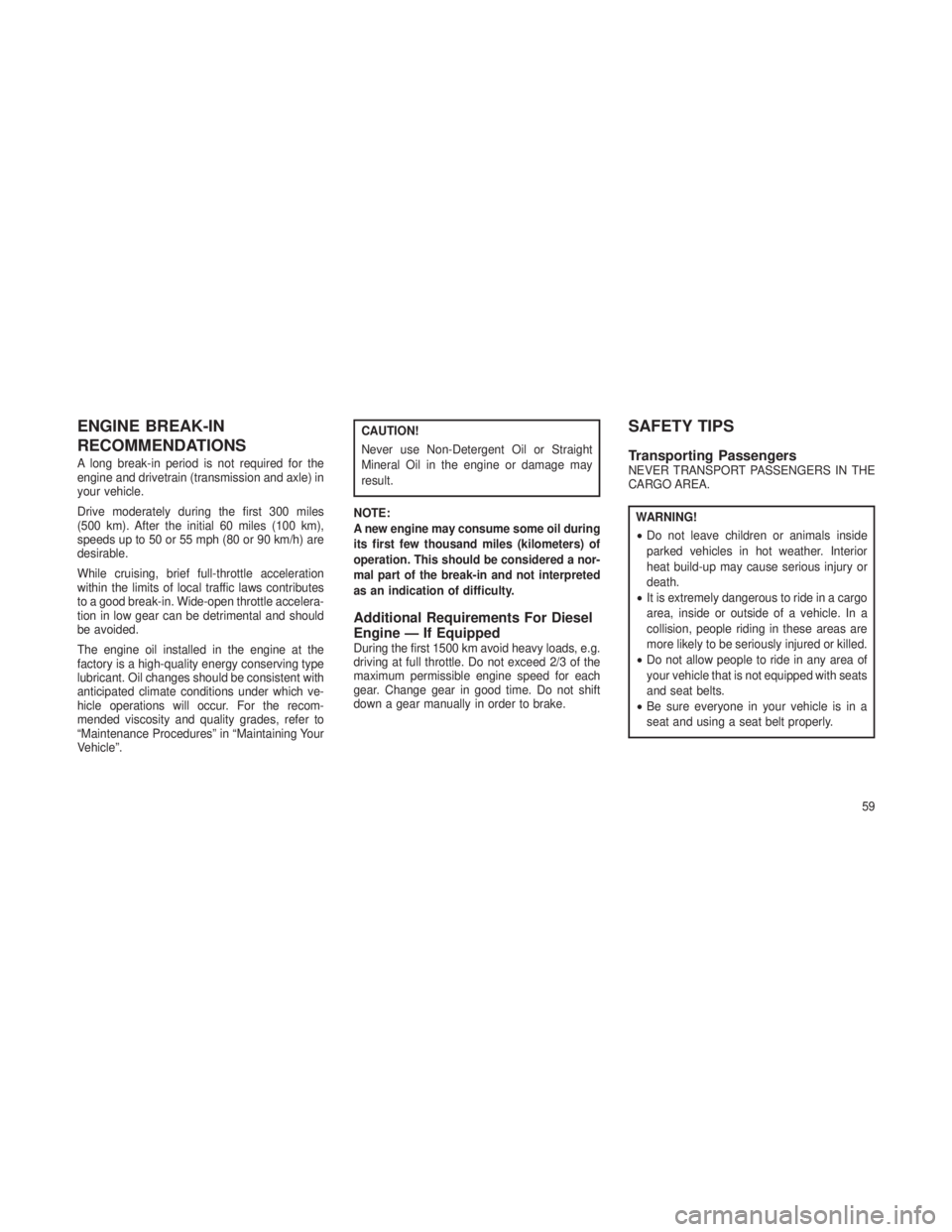
ENGINE BREAK-IN
RECOMMENDATIONS
A long break-in period is not required for the
engine and drivetrain (transmission and axle) in
your vehicle.
Drive moderately during the first 300 miles
(500 km). After the initial 60 miles (100 km),
speeds up to 50 or 55 mph (80 or 90 km/h) are
desirable.
While cruising, brief full-throttle acceleration
within the limits of local traffic laws contributes
to a good break-in. Wide-open throttle accelera-
tion in low gear can be detrimental and should
be avoided.
The engine oil installed in the engine at the
factory is a high-quality energy conserving type
lubricant. Oil changes should be consistent with
anticipated climate conditions under which ve-
hicle operations will occur. For the recom-
mended viscosity and quality grades, refer to
“Maintenance Procedures” in “Maintaining Your
Vehicle”.
CAUTION!
Never use Non-Detergent Oil or Straight
Mineral Oil in the engine or damage may
result.
NOTE:
A new engine may consume some oil during
its first few thousand miles (kilometers) of
operation. This should be considered a nor-
mal part of the break-in and not interpreted
as an indication of difficulty.
Additional Requirements For Diesel
Engine — If Equipped
During the first 1500 km avoid heavy loads, e.g.
driving at full throttle. Do not exceed 2/3 of the
maximum permissible engine speed for each
gear. Change gear in good time. Do not shift
down a gear manually in order to brake.
SAFETY TIPS
Transporting PassengersNEVER TRANSPORT PASSENGERS IN THE
CARGO AREA.
WARNING!
• Do not leave children or animals inside
parked vehicles in hot weather. Interior
heat build-up may cause serious injury or
death.
• It is extremely dangerous to ride in a cargo
area, inside or outside of a vehicle. In a
collision, people riding in these areas are
more likely to be seriously injured or killed.
• Do not allow people to ride in any area of
your vehicle that is not equipped with seats
and seat belts.
• Be sure everyone in your vehicle is in a
seat and using a seat belt properly.
59
Page 64 of 408
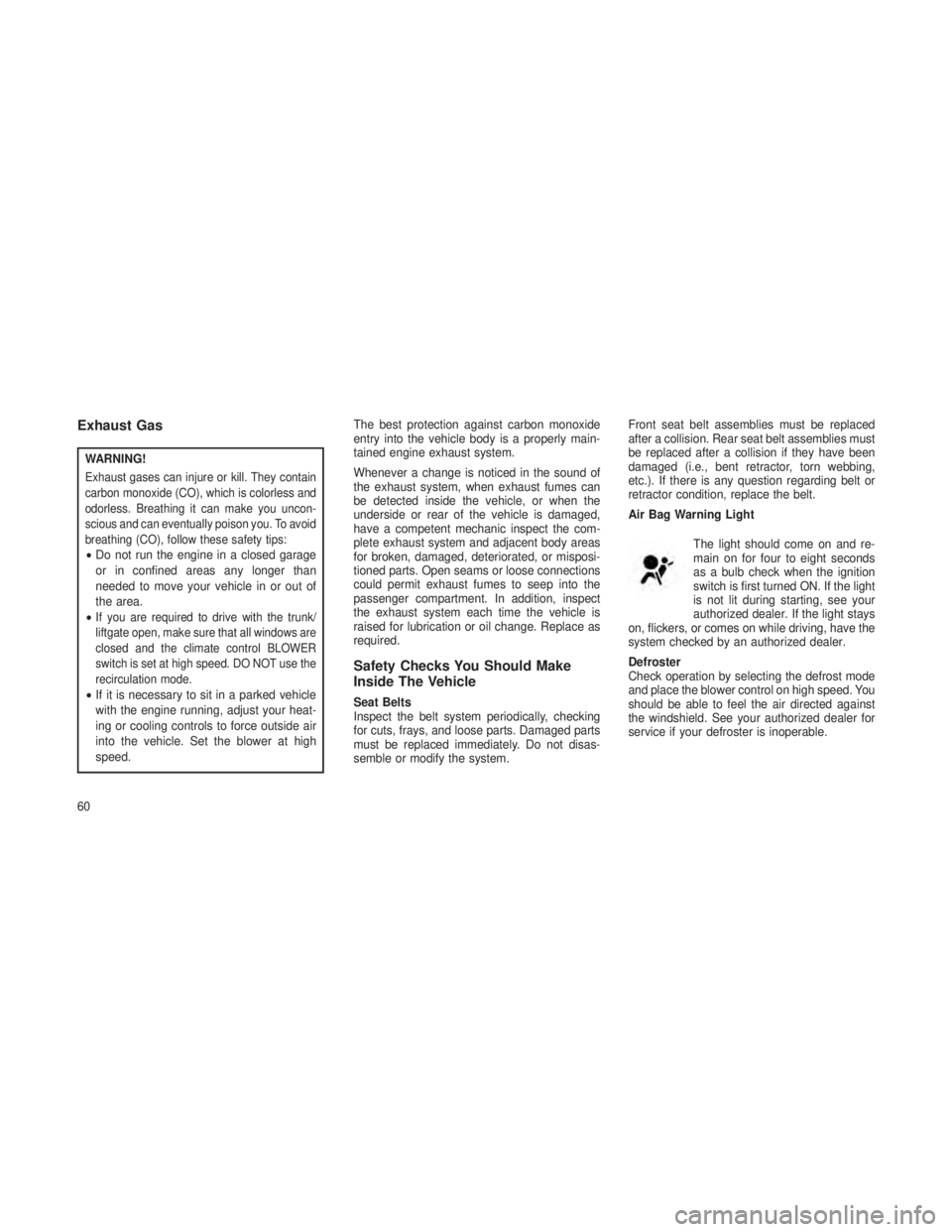
Exhaust Gas
WARNING!
Exhaust gases can injure or kill. They contain
carbon monoxide (CO), which is colorless and
odorless. Breathing it can make you uncon-
scious and can eventually poison you. To avoid
breathing (CO), follow these safety tips:
•Do not run the engine in a closed garage
or in confined areas any longer than
needed to move your vehicle in or out of
the area.
•
If you are required to drive with the trunk/
liftgate open, make sure that all windows are
closed and the climate control BLOWER
switch is set at high speed. DO NOT use the
recirculation mode.
• If it is necessary to sit in a parked vehicle
with the engine running, adjust your heat-
ing or cooling controls to force outside air
into the vehicle. Set the blower at high
speed. The best protection against carbon monoxide
entry into the vehicle body is a properly main-
tained engine exhaust system.
Whenever a change is noticed in the sound of
the exhaust system, when exhaust fumes can
be detected inside the vehicle, or when the
underside or rear of the vehicle is damaged,
have a competent mechanic inspect the com-
plete exhaust system and adjacent body areas
for broken, damaged, deteriorated, or misposi-
tioned parts. Open seams or loose connections
could permit exhaust fumes to seep into the
passenger compartment. In addition, inspect
the exhaust system each time the vehicle is
raised for lubrication or oil change. Replace as
required.
Safety Checks You Should Make
Inside The Vehicle
Seat Belts
Inspect the belt system periodically, checking
for cuts, frays, and loose parts. Damaged parts
must be replaced immediately. Do not disas-
semble or modify the system. Front seat belt assemblies must be replaced
after a collision. Rear seat belt assemblies must
be replaced after a collision if they have been
damaged (i.e., bent retractor, torn webbing,
etc.). If there is any question regarding belt or
retractor condition, replace the belt.
Air Bag Warning Light
The light should come on and re-
main on for four to eight seconds
as a bulb check when the ignition
switch is first turned ON. If the light
is not lit during starting, see your
authorized dealer. If the light stays
on, flickers, or comes on while driving, have the
system checked by an authorized dealer.
Defroster
Check operation by selecting the defrost mode
and place the blower control on high speed. You
should be able to feel the air directed against
the windshield. See your authorized dealer for
service if your defroster is inoperable.
60
Page 65 of 408
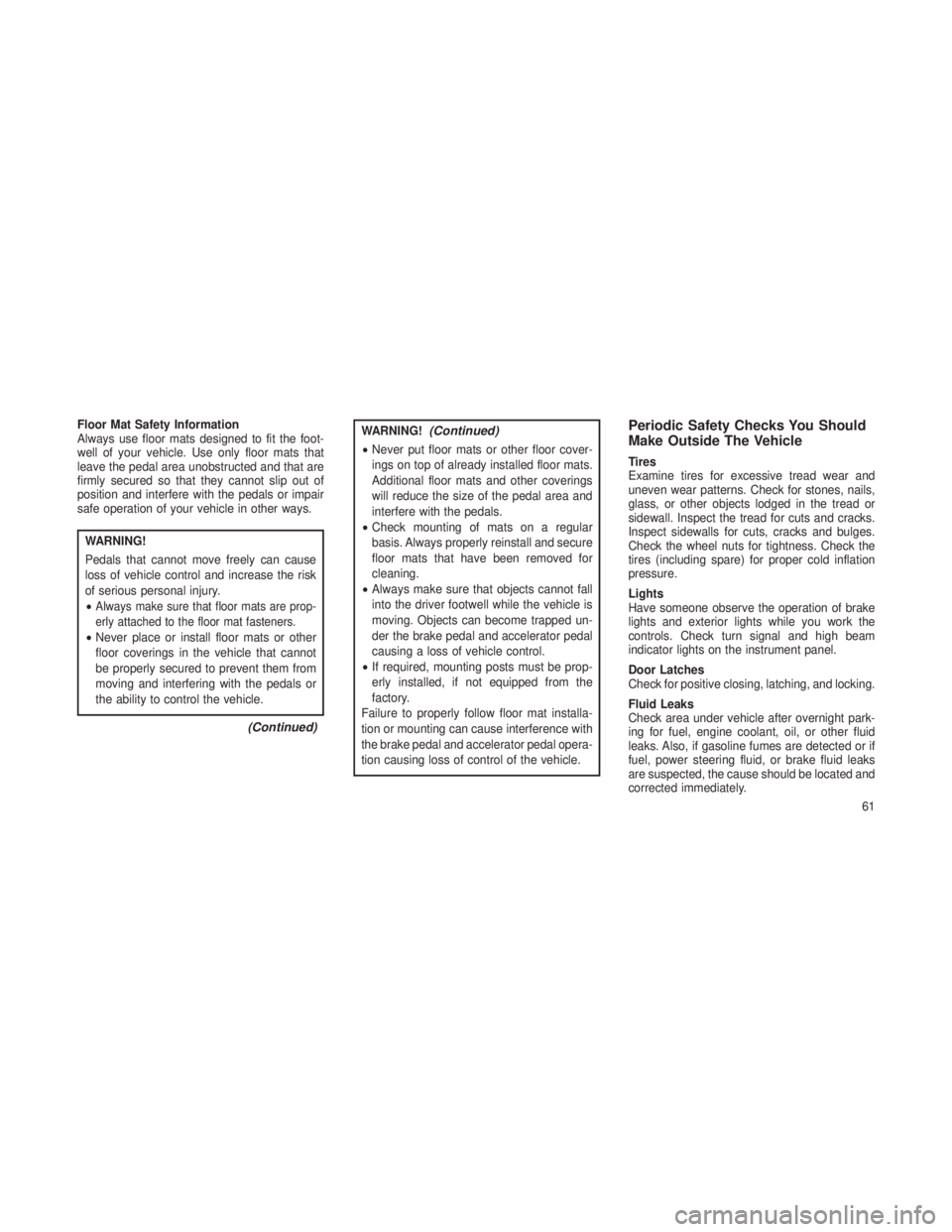
Floor Mat Safety Information
Always use floor mats designed to fit the foot-
well of your vehicle. Use only floor mats that
leave the pedal area unobstructed and that are
firmly secured so that they cannot slip out of
position and interfere with the pedals or impair
safe operation of your vehicle in other ways.
WARNING!
Pedals that cannot move freely can cause
loss of vehicle control and increase the risk
of serious personal injury.
•
Always make sure that floor mats are prop-
erly attached to the floor mat fasteners.
•Never place or install floor mats or other
floor coverings in the vehicle that cannot
be properly secured to prevent them from
moving and interfering with the pedals or
the ability to control the vehicle.
(Continued)
WARNING!(Continued)
•Never put floor mats or other floor cover-
ings on top of already installed floor mats.
Additional floor mats and other coverings
will reduce the size of the pedal area and
interfere with the pedals.
• Check mounting of mats on a regular
basis. Always properly reinstall and secure
floor mats that have been removed for
cleaning.
• Always make sure that objects cannot fall
into the driver footwell while the vehicle is
moving. Objects can become trapped un-
der the brake pedal and accelerator pedal
causing a loss of vehicle control.
• If required, mounting posts must be prop-
erly installed, if not equipped from the
factory.
Failure to properly follow floor mat installa-
tion or mounting can cause interference with
the brake pedal and accelerator pedal opera-
tion causing loss of control of the vehicle.
Periodic Safety Checks You Should
Make Outside The Vehicle
Tires
Examine tires for excessive tread wear and
uneven wear patterns. Check for stones, nails,
glass, or other objects lodged in the tread or
sidewall. Inspect the tread for cuts and cracks.
Inspect sidewalls for cuts, cracks and bulges.
Check the wheel nuts for tightness. Check the
tires (including spare) for proper cold inflation
pressure.
Lights
Have someone observe the operation of brake
lights and exterior lights while you work the
controls. Check turn signal and high beam
indicator lights on the instrument panel.
Door Latches
Check for positive closing, latching, and locking.
Fluid Leaks
Check area under vehicle after overnight park-
ing for fuel, engine coolant, oil, or other fluid
leaks. Also, if gasoline fumes are detected or if
fuel, power steering fluid, or brake fluid leaks
are suspected, the cause should be located and
corrected immediately.
61
Page 66 of 408

62
Page 67 of 408
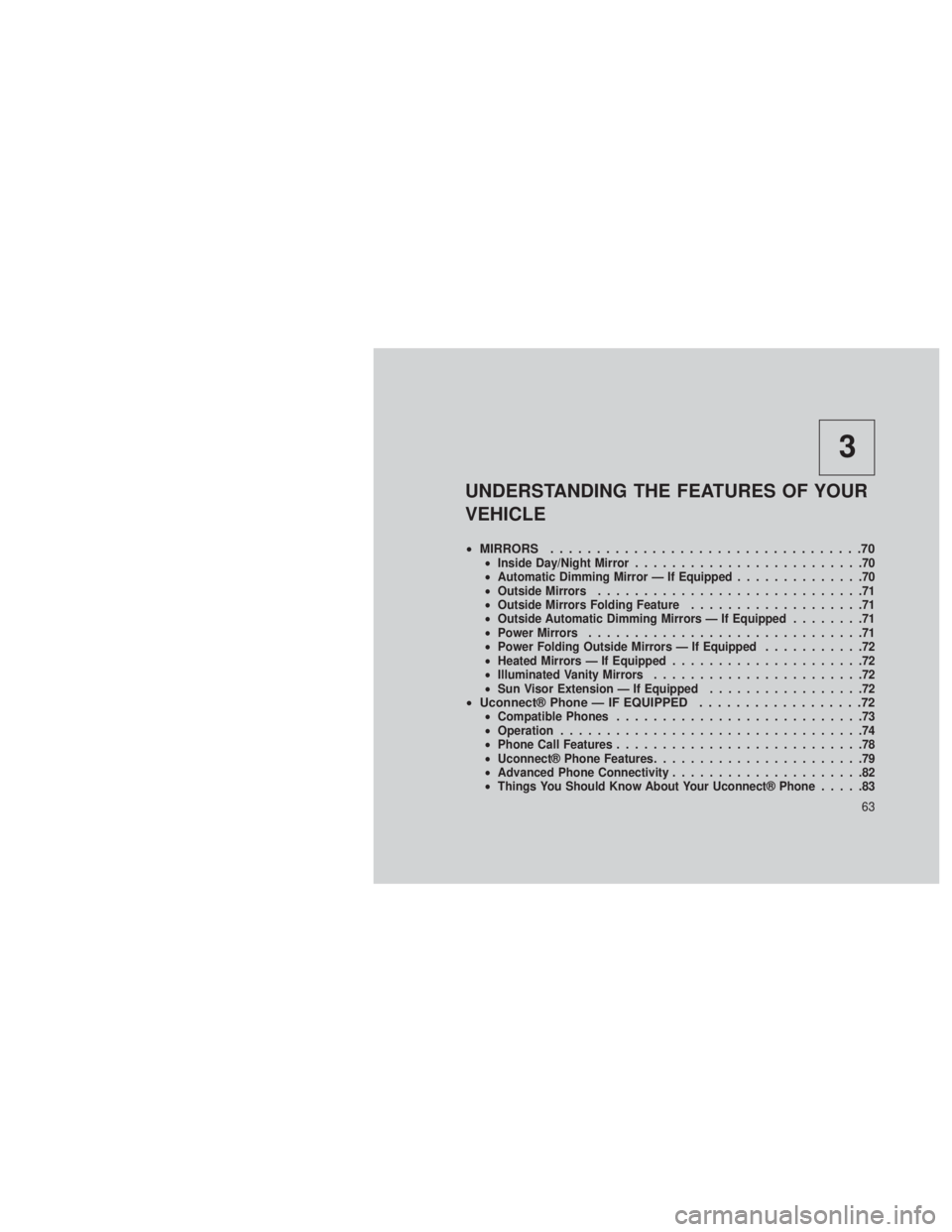
3
UNDERSTANDING THE FEATURES OF YOUR
VEHICLE
•MIRRORS ..................................70•Inside Day/Night Mirror .........................70
• Automatic Dimming Mirror — If Equipped ..............70
• Outside Mirrors .............................71
• Outside Mirrors Folding Feature ...................71
• Outside Automatic Dimming Mirrors — If Equipped ........71
• Power Mirrors ..............................71
• Power Folding Outside Mirrors — If Equipped ...........72
• Heated Mirrors — If Equipped .....................72
• Illuminated Vanity Mirrors .......................72
• Sun Visor Extension — If Equipped .................72
•Uconnect® Phone — IF EQUIPPED ..................72•Compatible Phones ...........................73
• Operation .................................74
• Phone Call Features ...........................78
• Uconnect® Phone Features .......................79
• Advanced Phone Connectivity .....................82
• Things You Should Know About Your Uconnect® Phone .....83
63
Page 68 of 408
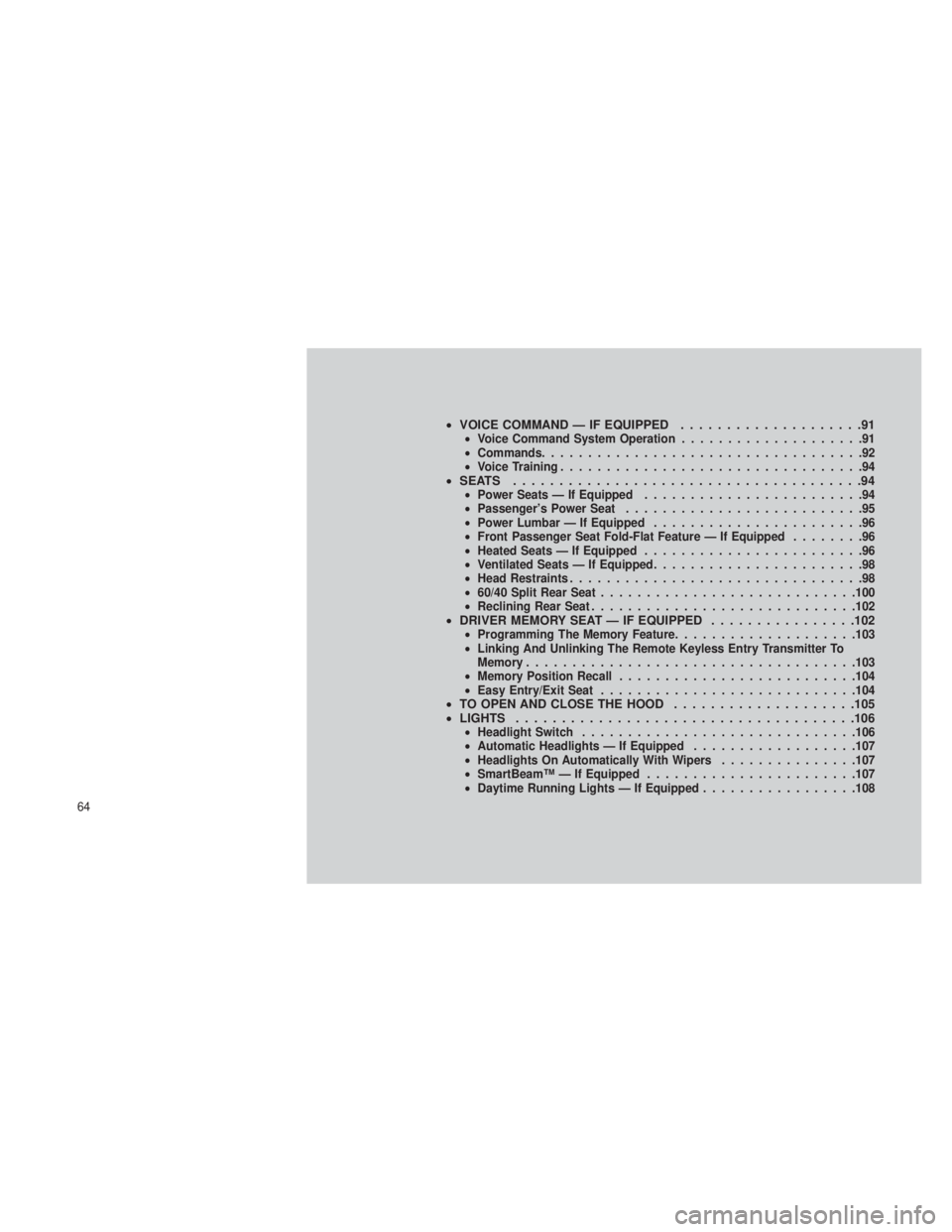
•VOICE COMMAND — IF EQUIPPED ....................91•Voice Command System Operation ....................91
• Commands ...................................92
• Voice Training .................................94
•SEATS ......................................94•Power Seats — If Equipped ........................94
• Passenger’s Power Seat ..........................95
• Power Lumbar — If Equipped .......................96
• Front Passenger Seat Fold-Flat Feature — If Equipped ........96
• Heated Seats — If Equipped ........................96
• Ventilated Seats — If Equipped .......................98
• Head Restraints ................................98
• 60/40 Split Rear Seat ........................... .100
• Reclining Rear Seat ............................ .102
•DRIVER MEMORY SEAT — IF EQUIPPED ................102•Programming The Memory Feature ....................103
• Linking And Unlinking The Remote Keyless Entry Transmitter To
Memory ................................... .103
• Memory Position Recall ......................... .104
• Easy Entry/Exit Seat ........................... .104
•TO OPEN AND CLOSE THE HOOD ....................105
• LIGHTS .....................................106
•Headlight Switch ............................. .106
• Automatic Headlights — If Equipped ..................107
• Headlights On Automatically With Wipers ...............107
• SmartBeam™ — If Equipped ...................... .107
• Daytime Running Lights — If Equipped .................108
64
Page 69 of 408

•Automatic Headlight Leveling — HID Headlights Only ......109
• Headlight Delay ............................ .109
• Parking Lights And Panel Lights ...................109
• Front And Rear Fog Lights — If Equipped .............109
• Interior Lights ............................. .109
• Lights-On Reminder ..........................110
• Battery Saver ..............................110
• Front Map/Reading Lights ......................110
• Courtesy Lights .............................111
• Ambient Light ..............................111
• Multifunction Lever ...........................112
• Turn Signals ...............................112
• Lane Change Assist ..........................112
• Flash-To-Pass ..............................112
• High/Low Beam Switch .........................112
•WINDSHIELD WIPERS AND WASHERS ...............112•Windshield Wiper Operation ......................113
• Intermittent Wiper System ......................113
• Windshield Washer Operation .....................113
• Mist ....................................114
• Rain Sensing Wipers — If Equipped ................114
•TILT/TELESCOPING STEERING COLUMN ..............115
• POWER TILT/TELESCOPING STEERING COLUMN — IF
EQUIPPED .................................116
• HEATED STEERING WHEEL — IF EQUIPPED ...........116
65
Page 70 of 408
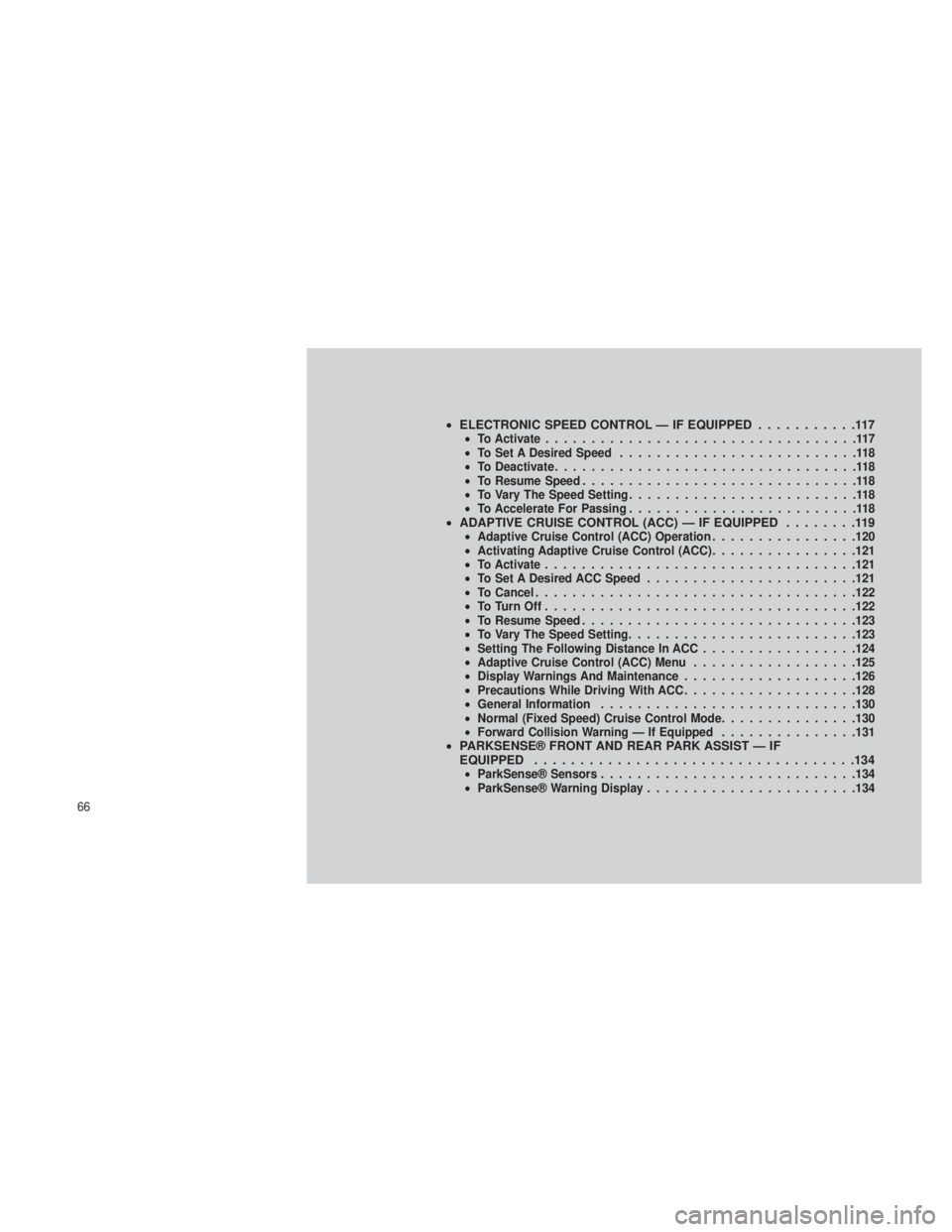
•ELECTRONIC SPEED CONTROL — IF EQUIPPED ...........117•To Activate ..................................117
• To Set A Desired Speed ..........................118
• To Deactivate .................................118
• To Resume Speed ..............................118
• To Vary The Speed Setting .........................118
• To Accelerate For Passing .........................118
•ADAPTIVE CRUISE CONTROL (ACC) — IF EQUIPPED ........119•Adaptive Cruise Control (ACC) Operation ................120
• Activating Adaptive Cruise Control (ACC) ................121
• To Activate ................................. .121
• To Set A Desired ACC Speed ...................... .121
• To Cancel .................................. .122
• ToTurnOff................................. .122
• To Resume Speed ............................. .123
• To Vary The Speed Setting ........................ .123
• Setting The Following Distance In ACC .................124
• Adaptive Cruise Control (ACC) Menu ..................125
• Display Warnings And Maintenance ...................126
• Precautions While Driving With ACC ...................128
• General Information ........................... .130
• Normal (Fixed Speed) Cruise Control Mode ...............130
• Forward Collision Warning — If Equipped ...............131
•PARKSENSE® FRONT AND REAR PARK ASSIST — IF
EQUIPPED ...................................134
•ParkSense® Sensors ........................... .134
• ParkSense® Warning Display ...................... .134
66